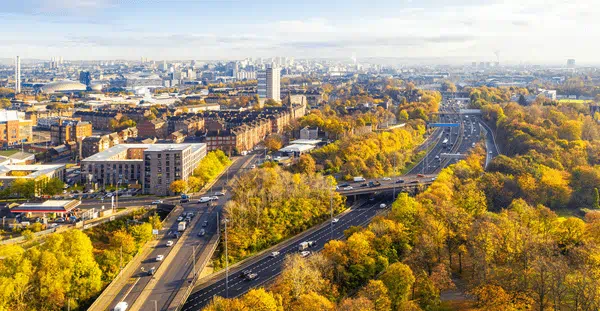Let's talk about the not-so-distant future: 2050. It's a year that looms large as a critical milestone for many companies on their path to net zero. It's a mere 27 years away – that’s five or six rounds of election promises from hopeful politicians vying for their spot at the top in many democratic countries like the UK, India, Canada, South Africa, or South Korea. If you're in Australia or New Zealand though, that expands to nine.
As wildfires and heatwaves soar across Europe and the US, we're left with an ever-present reminder of how unprepared we truly are for the effects of climate change. Our world is getting very hot, and there's a dwindling supply of shade, hats, and sunscreen left to slap on the problem. Rhetoric and good intentions can easily distract us from getting on with the important work of effecting change.
The transportation sector is a known and significant contributor to greenhouse gas emissions, and without major changes in policy, public and private investment, it will be nearly impossible to achieve our global decarbonization goals. Rome wasn't built in a day, and neither are our transport networks. With infrastructure projects often taking decades to move from planning to the end product, we must act urgently to build a sustainable future.
Back to the future…In solving for 2050, we often look forwards, but need to work backwards to redefine our future. If every company in the world is collectively aiming for net zero carbon by 2050, what does our future actually look like?
The answers I often hear are very fluid; perhaps flights and aeroplanes won't exist anymore, or else in Jetson’s style EV take-off landing vehicles will dominate travel in cities. Car-free cities have been on the cards for decades and will certainly play a pivotal role in high-transit areas, but will shared mobility and ride-sharing really hit the road?

Regardless of how our future may look, by working backward from the goal of 2050 to a more tangible milestone like 2035 (12 years from now), we can set actionable targets, align our efforts towards decarbonization, and direct meaningful investment to the areas that will help us achieve those targets.
If car companies like Toyota, Mitsubishi and G.M. can commit to not selling petrol cars by 2035, then what can our policy makers and project owners commit to, to lighten the collective carbon footprint?
Our world 27-years from now will be the product of both vision and data. Data acts as the smooth asphalt under our wheels, paving the way forward for future mobility solutions, and steering us towards our looming green horizon. The need for mobility isn’t going anywhere, but data can help us better understand current trends, usage patterns, anticipate future demands, and optimise infrastructure design and maintenance to ensure we’re not replacing one bad solution with another. Recent work we did with the WBCSD showed that data sharing can reduce carbon emissions from EV charging infrastructure by 15% and improve grid capacity.
Take, for example, pavement design. We know that there are around 7.4kg CO2 emissions per square meter of pavement each year of design life. My home country of Australia for example has around 800,000 km of road – of which 310,000 km is surfaced. The annual production of asphalt is about 10 million metric tonnes per year, and the annual use of bitumen is more than 800,000 metric tonnes. Those statistics identify a huge opportunity but also speak to the size of the problem.
By embedding sustainable decision-making into the early design process, Arcadis created a powerful sustainability assessment tool to measure embedded carbon and help our clients select the most carbon-efficient and long-term sustainable pavement options alongside cost considerations. We have exciting plans to expand this to broader infrastructure projects globally, and by adopting a life cycle approach to the holistic performance of mobility projects that consider whole-of-life environmental, social, and economic factors, we’ve empowered our clients to unlock new, innovative opportunities.
As engineers, our role continues to evolve. We do more than plan, design, build and walk-away. We are increasingly partners in the long-term management of critical city infrastructure. We can use technology to get the best performance from our assets - from monitoring for wear and tear, and through AI identifying issues and taking action before failure, so we can in fact, maintain our assets as opposed to fixing them. Our recent partnership with Niricson is a good example of how we can leverage digital technology to assess the condition of infrastructure in a non-invasive way without disruption to commuters.
As the clock continues to tick towards 2050, we must prioritize solutions to redefine our green future. Solutions are key; we can not rely on doom and gloom to galvanise global action. As political commentator Ezra Klein recently wrote in The New York Times, our "green future has to be a welcoming one, even a thrilling one. If people cannot see themselves in it, they will fight to stop it.”
We often look to scientists, policymakers, and activists to combat climate change, but as natural problem-solvers, engineers are in an ideal position to be agents of change. We have a critical role in this fight, with the technical expertise to translate theory into tangible action. We can bring about real change, but we also—critically—need the time to do it, something we have too little of at this point.
The world needs visionary and influential engineers who can embed sustainability at every level of our industry, pioneering critical mobility projects to decarbonise our cities and drive us towards a greener tomorrow. They exist. We are ready. But are we prepared to persuade and bring our clients and project owners with us? Engineers must look up from the detail and participate in the creation of the bigger picture…a net zero carbon future.
The task ahead may be daunting, but the future lies in the hands of engineers who possess the power to shape our world. By focusing on critical mobility projects, embracing ambitious goals, and leveraging our influence, engineers can lead the charge towards a greener and more sustainable future. Together, we can build the necessary foundations for a world where mobility and sustainability go hand in hand, ensuring a brighter future for generations to come.
Now, more than ever, we must foster leadership in our industry and across projects for the next generation of engineers. As we inch closer to 2050, engineers must confront the reality that time is not on our side. Decades-long infrastructure projects demand immediate action and foresight.




